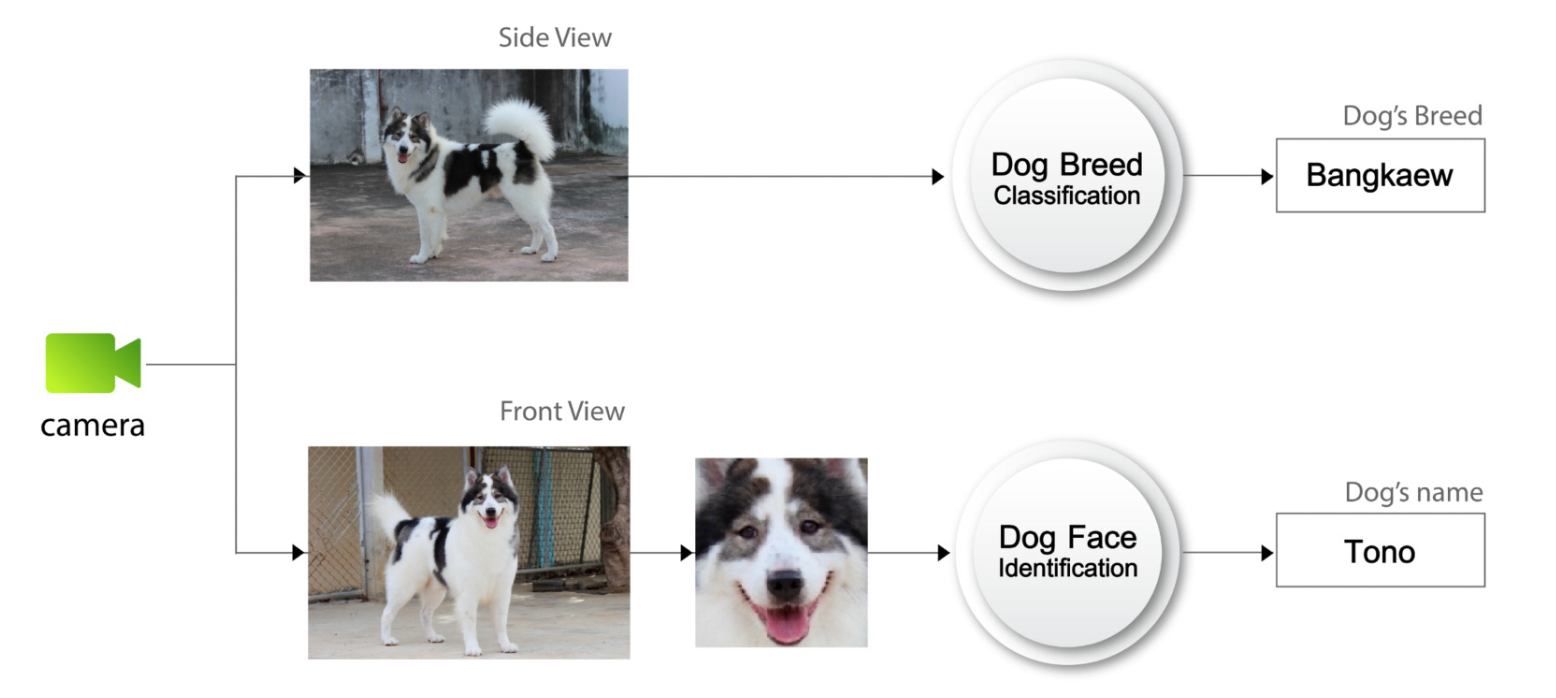Dog Breed Classification and Identification Using Convolutional Neural Networks
Main Article Content
Abstract
This study aimed to assess the effectiveness of using pre-trained models to extract biometric information, specifically the dog breed and dog identity, from images of dogs. The study employed pre-trained models to extract feature vectors from the dog images. Multi-Layer Perceptron (MLP) models then used these vectors as input to train dog breed and identity classifiers. The dog breeds used in this study comprised two Thai breeds, Bangkaew and Ridgeback, and 120 foreign breeds. For dog breed classification, the results showed that, among the ImageNet classification models, the pre-trained NasNetLarge model has the highest dog breed classification accuracy (91%). The newly trained MLP model, which used feature vectors obtained by NasNetLarge, achieved higher accuracy at 93%. For dog identification, the results showed that, without data augmentation, the pre-trained ResNet50 model had the highest dog identification accuracy (75%). However, with data augmentation, MobileNetV2 could achieve a higher accuracy of 77%. When evaluating the identification performance of each breed, it is important to note that pugs achieved the lowest identification rate at 57.4%. Conversely, Bangkaew dogs demonstrated outstanding performance, with the highest identification rate at 98.6%.
Article Details

This work is licensed under a Creative Commons Attribution-NonCommercial-NoDerivatives 4.0 International License.
References
F. Chollet, “Xception: Deep Learning with Depthwise Separable Convolutions,” 2017 IEEE Conference on Computer Vision and Pattern Recognition (CVPR), Honolulu, HI, USA, pp. 1800-1807, 2017.
K. Saraubon, AI: Deep Learning by Python. Bangkok, Thailand:Inter media, 2022.
C. Szegedy, V. Vanhoucke, S. Ioffe, J. Shlens and Z. Wojna, “Rethinking the Inception Architecture for Computer Vision,” 2016 IEEE Conference on Computer Vision and Pattern Recognition (CVPR), Las Vegas, NV, USA, pp. 2818-2826, 2016.
P.-L. Pr ̈ove. “MobileNetV2: Inverted Residuals and Linear Bottlenecks,” Retrieved from https://towardsdatascience.com/mobilenetv2-inverted-residuals-and-linear-bottlenecks-8a4362f4ffd5 (accessed.)
B. Zoph, V. Vasudevan, J. Shlens and Q. V. Le, “Learning Transferable Architectures for Scalable Image Recognition,” 2018 IEEE/CVF Conference on Computer Vision and Pattern Recognition, Salt Lake City, UT, USA, pp. 8697-8710, 2018.
W. Khan, A. Daud, F. Alotaibi, N. Aljohani, and S. Arafat, “Deep recurrent neural networks with word embeddings for Urdu named entity recognition,” ETRI Journal, vol. 42, no. 1, pp. 90–100, 2020.
D. T. Weerasekara, M. P. A. W. Gamage and K. S. A. F. Kulasooriya, “Combined Approach of Supervised and Unsupervised learning for Dog Face Recognition,” 2021 6th International Conference for Convergence in Technology (I2CT), Maharashtra, India, pp. 1-5, 2021.
M. V. Sai Rishita and T. Ahmed Harris, “Dog Breed Classifier using Convolutional Neural Networks,” 2018 International Conference on Networking, Embedded and Wireless Systems (ICNEWS), Bangalore, India, pp. 1-7, 2018.
A. Khosla, N. Jayadevaprakash, B. Yao, and F.-F. Li, “Novel dataset for fine-grained image categorization: Stanford dogs,” in Proc. CVPR workshop on fine-grained visual categorization (FGVC), vol. 2, no. 1, 2011.
T. Pinheiro Moreira, M. Lisboa Perez, R. de Oliveira Werneck, and E. Valle, “Where Is My Puppy? Retrieving Lost Dogs by Facial Features,” arXiv e-prints, p. arXiv: 1510.02781, 2015.
A. Vlachynska, Z. K. Oplatkova, and T. Turecek, “Dogface Detection and Localization of Dogface’s Landmarks,” Artificial Intelligence and Algorithms in Intelligent Systems. CSOC2018 2018. Advances in Intelligent Systems and Computing,Springer, Cham, vol. 764, pp. 465-476, 2019.


